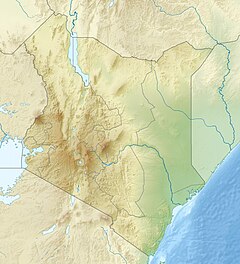Panga ya Saidi
 | |
| Location | Kilifi County of Kenya |
|---|---|
| Region | Kenya |
| Coordinates | 3°40′43″S 39°44′9″E / 3.67861°S 39.73583°E |
Panga ya Saidi is an archaeological cave site located in
The archaeological potential of Panga ya Saidi was first noted by Robert Soper

Site setting
The site is located in Southern Kenya's Nyali Coast region.
Stratigraphy and dating
Based on a 3 meter deep excavation of the archaeological site, a sequence of 19 layers were found and divided by three lithographic boundaries into four groups. The oldest group consisted of Layers 19 - 17 (dated to 76,000-73,000 years ago) characterized primarily by reddish-brown clay loams with bone fragments from mollusk shells and mammals, and appears to lack any structures. The unit is interpreted as a period of sporadic human occupation. Layers 16 - 14 (67,000-59,000 years ago) consisted mostly of orange-brown slit-like loam with deposits of ash and bedrock clasts. There is an increased presence of human activity with lithics, bone fragments, and charcoal flakes appearing in Layers 15 & 14. Unit II is interpreted as a floor level, with accumulated wall and roof collapses and evidence of burning. Unit III with layers 13 - 5 (59,000-14,000 years ago) contains heterogenous loam with abundant evidence of human activity and ash, with the presence of hearths, burning, lithics, and floor hollows. The Layer 13/12 boundary at about 51,000 years ago reflects a hiatus between two different occupational phases. The increase of human activity is shown by the concentration of human-occupation byproducts, however occupation is intermittent. Finally, Unit IV, or layers 4 -1 (8000 years ago to 400 years ago), consists of loose and silty loam with deposits of charcoal, bone fragments, marine shells, and lithics. The layers are disturbed, with degradation of the cave walls and floor reflecting intermittent human occupation (including a burial and hearths).[1]
Middle and Later Stone Age occupations
Stone tools
There are important changes over time in the lithic technology sequence at Panga ya Saidi.
However, the archaeologists note that this is not a dramatic transition, since Levallois techniques continue to be used throughout much of the Panga ya Saidi sequence, even after new technologies appear. This suggests that the Middle to Later Stone Age transition cannot be described in simplistic terms or as a single package.[10] The archaeologists conclude that the defining feature of this transition at Panga ya Saidi is miniaturization, rather than specific tool types or reduction techniques.[9]
Faunal remains
Mostly small bovids (like duiker and suni), suids (warthog and bushpig), and some primates were found in the faunal remains as the basis of subsistence,[12] while marine faunal remains are understood to be mostly utilized symbolically in the material culture (such as marine shell beads) until the Holocene, when they were also used for consumption.[11]
Tropical environments like those found in coastal eastern Africa were deemed to be a sort of refugium for early human populations, due to their comparatively stable environment and the abundance of edible fauna from the exploitation of the closed forests, woodland and grassland environments.[12]
Human remains
A deciduous second molar of a child was found in some of the deepest deposits at Panga ya Saidi, located in Layer 18 and dating to about 78,000 years ago (MIS 5).
Evidence of modern behaviour was found in 2021 when evidence of Africa's earliest intentional burial was found. A 78,000 year old Middle Stone Age grave of a three-year-old child was discovered in Panga ya Saidi cave. Researchers said the child's head appeared to have been laid on a pillow. The body had been laid in a fetal position.[17] However, this alleged burial is tens of thousands of years younger than burials at Skhul and Qafzeh cave, in Israel whom belonged to African populations with the same African lithic cultural tradition.[18]
Iron Age occupations
Plant remains
During the
Faunal remains
The expansion of agro-pastoral and maritime trade networks during the last 1300 years of occupation at the Panga ya Saidi site, supported by coastal faunal and botanical remains, indicate long-term habitation of these coastal sites during the Late Iron Age. As well, evidence from carbon and oxygen stable isotopes and zooarchaeological data show that people hunted African bovids (like those listed above), and that the environment was semi-closed forest during the Iron Age.[12]
Panga ya Saidi contained a high concentration of murid remains, but mainly these were local rodents, and not the nonnative species Asian black rat (Rattus rattus). The rodent remains obtained from Panga ya Saidi were identified using collagen fingerprinting or ZooMS. The majority of the rodent specimens at Panga ya Saidi were found to be local murids, with the only confirmed R. rattus specimen being found relatively near the surface of the site.[14]
Human remains
The Iron Age burial discovered at Panga ya Saidi was dated to approximately 400 years ago by direct AMS radiocarbon dating.
References
- ^ PMID 29743572.
- S2CID 204756466.
- ^ "Kenyan Cave Provides New Insights into Later Stone Age | Archaeology, Paleoanthropology | Sci-News.com". Breaking Science News | Sci-News.com. Retrieved 2021-03-18.
- ^ Daley, Jason. "People Lived in This Cave for 78,000 Years". Smithsonian Magazine. Retrieved 2021-03-18.
- ^ Soper, Robert (1975). Notes on some caves in Kilifi District. Nairobi: Caves Exploration Group of the East African Society.
- ^ Helm, Richard (2000). Conflicting histories: the archaeology of the iron-working, farming communities in the central and southern coast region of Kenya. PhD, University of Bristol.
- ^ Sealinks Project
- S2CID 135471087.
- ^ S2CID 232231854.
- ^ a b c McDermott, Amy (2021). "Small, sharp blades mark the change from Middle to Later Stone Age in coastal Kenya | National Academy of Sciences". blog.pnas.org. Retrieved 2021-04-20.
- ^ S2CID 212693806.
- ^ S2CID 210641006.
- ^ PMID 27247383.
- ^ PMID 28817590.
- ^ S2CID 56168494.
- ^ PMID 28938123.
- .
- ISSN 1145-3370.
- ^ ISSN 1040-6182.

